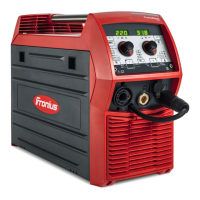Keep persons, especially children, away during the operation of the devices and during
the welding process. If persons are in the vicinity, however:
- Instruct them about all hazards (blinding hazard due to arcs, risk of injury from flying
sparks, welding fumes hazardous to health, noise exposure, possible hazard due to
grid current or welding current, etc.)
- Provide suitable protective equipment or
- Construct suitable protective walls and curtains.
Data regarding
Noise Emission
Values
The device produces a maximum noise level of <80 dB(A) (ref. 1pW) when idling and in
the cooling phase following operation in relation to the maximum permitted operating
point at standard loading in accordance with EN 60974-1.
A workplace-specific emission value for welding (and cutting) cannot be specified
because this value depends on the welding process and the environmental conditions. It
is influenced by a wide range of parameters, such as the welding process itself (MIG/
MAG, TIG welding), the selected current type (direct current, alternating current), the
power range, the type of weld metal, the resonance properties of the workpiece, the
workplace environment, and many other factors.
Danger from
toxic gases and
vapors
The fumes produced during welding contain toxic gases and vapors.
Welding fumes contain substances that cause cancer, as stated in monograph 118 from
the International Agency for Research on Cancer.
Use at-source extraction source and a room extraction system.
If possible, use a welding torch with an integrated extraction device.
Keep your head out of the welding fumes and gases.
Take the following precautionary measures for fumes and harmful gases:
- Do not breathe them in.
- Extract them from the work area using appropriate equipment.
Ensure that there is a sufficient supply of fresh air. Ensure that there is a ventilation flow
rate of at least 20 m³ per hour.
Use a welding helmet with air supply if there is insufficient ventilation.
If there is uncertainty as to whether the extraction capacity is sufficient, compare the
measured toxic emission values against the permissible limit values.
The following components are factors that determine how toxic the welding fumes are:
- The metals used for the workpiece
- Electrodes
- Coatings
- Cleaning agents, degreasers, and the like
- The welding process used
Consult the corresponding material safety data sheets and manufacturer's instructions
for the components listed above.
Recommendations for exposure scenarios, risk management measures and identifying
working conditions can be found on the European Welding Association website under
Health & Safety (https://european-welding.org).
Keep flammable vapors (such as solvent vapors) out of the arc radiation range.
When no welding is taking place, close the valve of the shielding gas cylinder or the main
gas supply.
10

